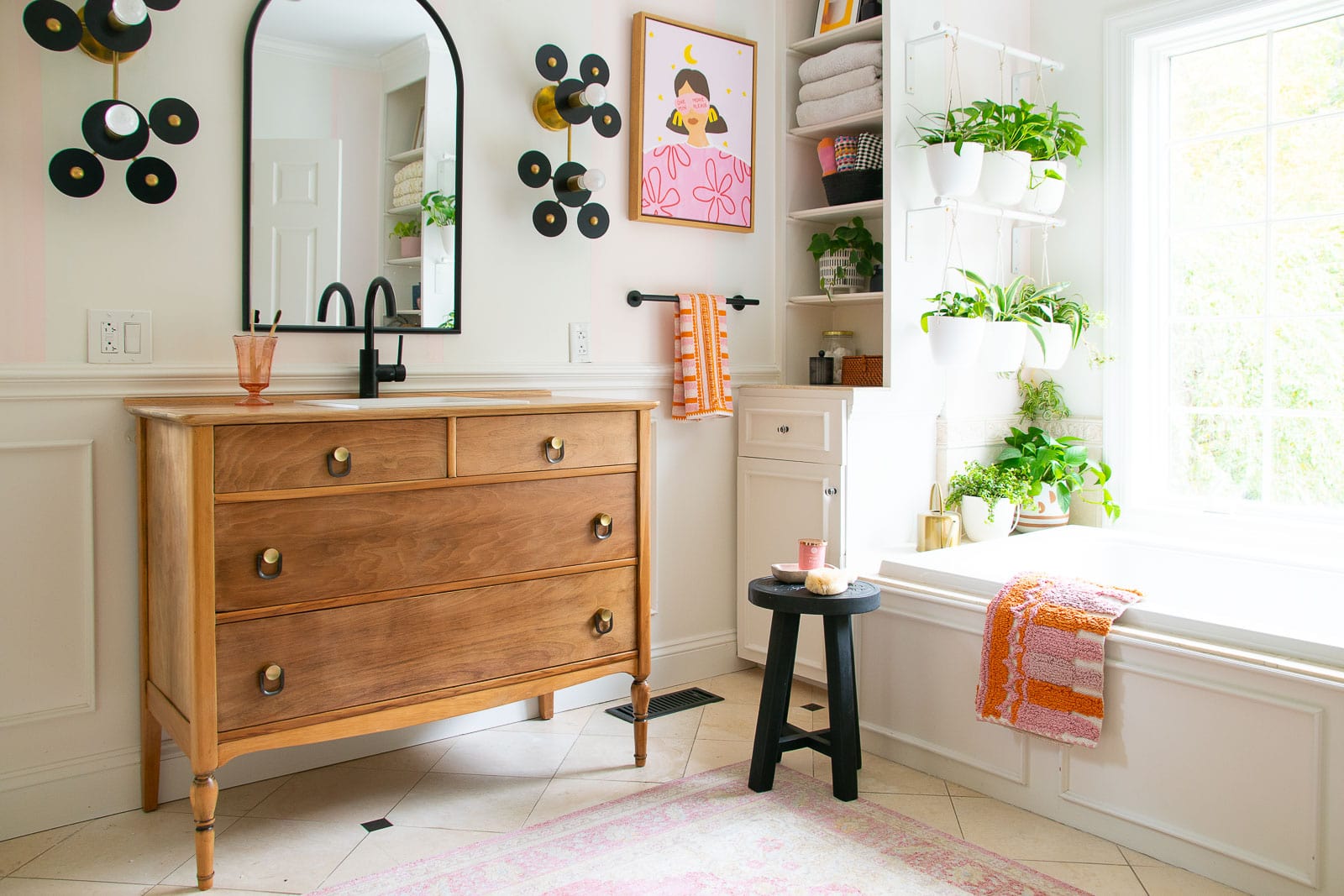The Allure of Antique Dressers as Bathroom Vanities
Antique dressers, with their rich history and intricate craftsmanship, have emerged as a captivating choice for modern bathroom vanities. These pieces offer a unique blend of timeless elegance and practical functionality, transforming a simple bathroom space into a sanctuary of vintage charm.
The Historical Context and Craftsmanship of Antique Dressers
Antique dressers, often crafted from solid wood like oak, mahogany, or walnut, represent a bygone era of meticulous craftsmanship. Each piece reflects the skilled hands of artisans who meticulously carved intricate details, hand-painted finishes, and meticulously assembled durable joinery. Their construction embodies a commitment to quality and longevity, a stark contrast to the mass-produced furniture of today. The historical context adds depth and character to these pieces, each one telling a story of its own.
Design Elements Contributing to a Unique Aesthetic
The design elements of antique dressers contribute significantly to their allure as bathroom vanities.
- Intricate Carvings: Antique dressers often feature intricate carvings that add a touch of artistry and sophistication. These carvings, ranging from delicate floral motifs to elaborate scrollwork, transform the dresser into a work of art.
- Ornate Hardware: The hardware on antique dressers, such as drawer pulls, hinges, and escutcheons, is often a statement piece. These decorative elements, often made of brass, bronze, or silver, add a touch of elegance and vintage charm.
- Unique Finishes: Antique dressers often boast unique finishes that enhance their aesthetic appeal. From hand-painted designs to distressed wood finishes, these finishes contribute to the character and charm of the piece.
Examples of Antique Dresser Styles Well-Suited for Bathroom Vanities
Various antique dresser styles lend themselves well to bathroom vanities, each offering a distinct aesthetic.
- Victorian Dressers: Known for their elaborate carvings, ornate hardware, and dark wood finishes, Victorian dressers create a grand and elegant bathroom atmosphere. Their imposing presence adds a touch of vintage grandeur to the space.
- Art Deco Dressers: Art Deco dressers, with their geometric patterns, sleek lines, and metallic accents, offer a modern and sophisticated aesthetic. Their bold design creates a statement piece in a contemporary bathroom.
- Mid-Century Dressers: Mid-century dressers, characterized by their clean lines, simple designs, and use of natural materials, bring a touch of retro charm to the bathroom. Their minimalist aesthetic complements modern bathroom styles.
Benefits and Drawbacks of Using Antique Dressers in Modern Bathrooms
The use of antique dressers in modern bathrooms presents both benefits and drawbacks.
- Benefits:
- Unique and Distinctive Style: Antique dressers offer a unique and distinctive style that sets them apart from mass-produced furniture.
- Historical Charm: The historical context and craftsmanship of antique dressers add a touch of vintage charm and elegance to the bathroom.
- Durability: Antique dressers, crafted from solid wood and with meticulous joinery, are often built to last, providing a long-lasting and sustainable solution for bathroom vanities.
- Drawbacks:
- Size and Scale: Antique dressers can be large and imposing, requiring careful consideration of the bathroom’s size and layout.
- Maintenance: Antique dressers often require specialized care and maintenance to preserve their finishes and integrity.
- Cost: Antique dressers can be expensive, particularly those in good condition and with desirable features.
Restoring and Upcycling Antique Dressers for Bathroom Use: Antique Dresser Bathroom Vanity

Transforming an antique dresser into a bathroom vanity is a rewarding project that blends historical charm with modern functionality. The process involves restoring the dresser to its former glory while adapting it for bathroom use. This includes cleaning, refinishing, and waterproofing the piece, ensuring it withstands the unique demands of a bathroom environment.
Restoring an Antique Dresser
Restoring an antique dresser for bathroom use requires a combination of careful cleaning, refinishing, and waterproofing techniques. This process ensures the dresser is not only aesthetically pleasing but also durable and functional in a humid environment.
Cleaning the Dresser
Before embarking on any restoration, it is essential to thoroughly clean the dresser to remove dirt, grime, and any previous finishes. This allows for a clean slate for refinishing.
- Begin by dusting the dresser with a soft cloth to remove loose dirt and debris.
- Use a mild soap and water solution to clean the dresser’s surface, avoiding harsh chemicals that could damage the antique finish.
- Pay particular attention to crevices and intricate details, ensuring they are thoroughly cleaned.
- Allow the dresser to dry completely before proceeding to the next step.
Refinishing the Dresser
Refinishing an antique dresser involves removing old finishes and applying new ones to enhance its beauty and protect its wood.
- If the dresser has a painted finish, use a paint stripper to remove it. Follow the manufacturer’s instructions carefully and wear appropriate protective gear.
- For a varnished finish, use a sanding block or an electric sander to remove the varnish. Start with coarse-grit sandpaper and gradually work your way to finer grits to achieve a smooth surface.
- Once the old finish is removed, apply a wood filler to any cracks or imperfections. Allow the filler to dry completely before sanding it smooth.
- Apply a stain to the dresser, if desired, to enhance its natural wood grain. Choose a stain color that complements the bathroom’s decor.
- Finish the dresser with a clear sealant, such as polyurethane or varnish, to protect it from moisture and wear. Apply multiple coats for optimal protection.
Waterproofing the Dresser
Waterproofing the dresser is crucial to protect it from the moisture prevalent in bathrooms. This step ensures the dresser remains durable and prevents water damage.
- Apply a waterproof sealant to the dresser’s surface, focusing on areas that are prone to water exposure, such as the top, drawers, and base.
- Consider using a sealant specifically designed for bathroom use, as it provides a higher level of moisture resistance.
- Allow the sealant to dry completely before using the dresser as a vanity.
Essential Tools and Materials
Restoring an antique dresser for bathroom use requires a specific set of tools and materials to ensure a successful and safe project.
- Cleaning Supplies: Soft cloth, mild soap, water, paint stripper (if necessary), sanding block or electric sander.
- Refinishing Supplies: Wood filler, sandpaper (various grits), stain (optional), clear sealant (polyurethane or varnish).
- Waterproofing Supplies: Waterproof sealant (specifically designed for bathroom use).
- Protective Gear: Gloves, mask, eye protection.
- Other Tools: Screwdriver, drill, measuring tape, level.
Safety Precautions
When handling antique furniture, it is essential to prioritize safety to avoid injury and damage to the piece.
- Wear protective gear, including gloves, a mask, and eye protection, when working with chemicals, such as paint stripper or sealant.
- Use proper ventilation when working with chemicals to prevent inhaling fumes.
- Handle antique furniture with care, avoiding sudden movements or dropping it.
- If the dresser has any loose or unstable parts, secure them before proceeding with restoration.
Upcycling an Antique Dresser
Upcycling an antique dresser for a bathroom vanity offers endless possibilities for creative expression. By adding new hardware, painting, and incorporating storage solutions, you can transform the dresser into a unique and functional piece.
Adding New Hardware
Replacing the original hardware with new pieces can instantly update the dresser’s look.
- Consider using modern hardware, such as brushed nickel or chrome, for a contemporary feel.
- If you prefer a vintage aesthetic, look for antique hardware or replicas.
- Choose hardware that complements the bathroom’s overall style and color scheme.
Painting the Dresser
Painting the dresser allows you to customize its color and create a unique look.
- Choose a paint color that complements the bathroom’s decor and personal style.
- Consider using a high-gloss paint for a modern look or a matte finish for a more traditional feel.
- Apply multiple coats of paint for a smooth and even finish.
Incorporating Storage Solutions
Adding storage solutions to the dresser can enhance its functionality and organization.
- Install a mirror above the dresser to create a vanity-like feel.
- Add a shelf or drawer organizer to maximize storage space.
- Consider incorporating a pull-out tray or a built-in trash can for added convenience.
Integrating Antique Dressers into Bathroom Design

Antique dressers, with their timeless elegance and intricate details, can transform a bathroom into a sanctuary of style and charm. Integrating an antique dresser into your bathroom design can create a unique and personalized space that reflects your individual taste.
Visual Guide for Integrating Antique Dressers into Various Bathroom Styles
Antique dressers can be seamlessly integrated into various bathroom styles, adding a touch of vintage charm to any space.
- Farmhouse Bathroom: Pair a distressed antique dresser with rustic wooden accents, such as a weathered mirror and woven baskets. The dresser’s patina and natural wood finish complement the farmhouse aesthetic, creating a warm and inviting atmosphere.
- Modern Bathroom: An antique dresser can add a touch of vintage elegance to a modern bathroom. Choose a dresser with clean lines and a minimalist design, and pair it with sleek fixtures and accessories. Consider painting the dresser in a bold color to create a statement piece.
- Traditional Bathroom: For a traditional bathroom, choose an antique dresser with ornate details and a classic finish. Pair it with traditional fixtures and accessories, such as a clawfoot tub and crystal doorknobs. The dresser’s intricate carvings and rich wood tones will enhance the traditional ambiance.
Designing a Bathroom Layout with an Antique Dresser Vanity as the Focal Point, Antique dresser bathroom vanity
To create a bathroom design with an antique dresser vanity as the focal point, consider the following layout ideas:
- Center Stage: Position the antique dresser vanity in the center of the room, allowing it to be the primary visual element. This creates a symmetrical and balanced layout, highlighting the dresser’s beauty and elegance.
- Wall-Mounted: Mount the antique dresser vanity on the wall to create a floating effect. This maximizes floor space and creates a sense of openness. Consider adding a mirror above the dresser to enhance the visual impact.
- Corner Placement: Utilize a corner space to accommodate the antique dresser vanity, especially in smaller bathrooms. This maximizes space and creates a cozy and intimate atmosphere.
Choosing Complementary Bathroom Fixtures and Accessories
Selecting complementary bathroom fixtures and accessories is crucial for enhancing the antique dresser’s character and creating a cohesive design.
- Faucet Styles: Consider using antique-style faucets or vintage-inspired fixtures to complement the dresser’s age and character. For a farmhouse bathroom, opt for brushed nickel or oil-rubbed bronze faucets. For a modern bathroom, choose sleek chrome or black faucets.
- Mirrors: A mirror above the antique dresser vanity is essential for adding visual interest and creating a sense of spaciousness. Consider a vintage-inspired mirror with ornate detailing or a simple, modern mirror to contrast with the dresser’s traditional charm.
- Lighting: Choose lighting fixtures that complement the dresser’s style. For a farmhouse bathroom, consider using pendant lights with exposed bulbs or vintage sconces. For a modern bathroom, opt for sleek, minimalist lighting fixtures.
Creating a Cohesive and Stylish Bathroom Design
To create a cohesive and stylish bathroom design using an antique dresser vanity, consider these tips:
- Color Palette: Choose a color palette that complements the dresser’s finish and style. For a farmhouse bathroom, consider using neutral colors such as white, beige, and gray, with accents of natural wood tones. For a modern bathroom, opt for a bold color scheme with black, white, and metallic accents.
- Textiles: Add soft textiles, such as towels, rugs, and curtains, to create a cozy and inviting atmosphere. Choose fabrics that complement the dresser’s style and color scheme. For a farmhouse bathroom, consider using linen or cotton towels with natural textures. For a modern bathroom, opt for smooth, minimalist textiles in bold colors.
- Accessorize: Add decorative accessories, such as candles, plants, and artwork, to personalize the space and enhance the antique dresser’s character. Choose accessories that complement the dresser’s style and the overall bathroom design.
